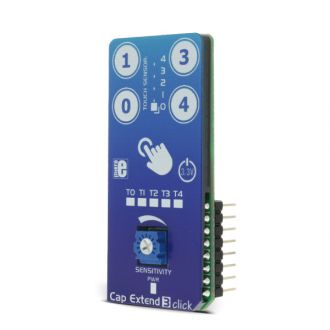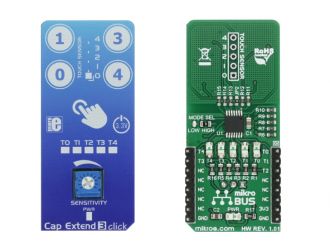
We strongly encourage users to use Package manager for sharing their code on Libstock website, because it boosts your efficiency and leaves the end user with no room for error. [more info]

Rating:
Author: MIKROE
Last Updated: 2018-01-25
Package Version: 1.0.0.0
mikroSDK Library: 1.0.0.0
Category: Proximity
Downloaded: 6048 times
Not followed.
License: MIT license
Cap Extend 3 click features four capacitive sensor pads integrated on the PCB, that can sense touch through a variety of different materials.
Do you want to subscribe in order to receive notifications regarding "Cap Extend 3 click" changes.
Do you want to unsubscribe in order to stop receiving notifications regarding "Cap Extend 3 click" changes.
Do you want to report abuse regarding "Cap Extend 3 click".


Library Description
Initializes GPIO driver and click driver functions, which detect a touch on determined pins. For more details, check the documentation.
Key functions
uint8_t capextend3_Touch_0()- The function reads a state of the AN pin.
uint8_t capextend3_Touch_1()- The function reads a state of the RST pin.
uint8_t capextend3_Touch_2()- The function reads a state of the CS pin.
uint8_t capextend3_Touch_3()- The function reads a state of the INT pin.
uint8_t capextend3_Touch_4()- The function reads a state of the PWM pin.
Examples Description
The demo application is composed of three sections:
void applicationTask()
{
touch_1 = capextend3_Touch_1();
touch_0 = capextend3_Touch_0();
touch_3 = capextend3_Touch_3();
touch_4 = capextend3_Touch_4();
if( touch_0 == 0 )
mikrobus_logWrite("Touch 0 ",_LOG_LINE);
if( touch_1 == 0 )
mikrobus_logWrite("Touch 1 ",_LOG_LINE);
if( touch_3 == 0 )
mikrobus_logWrite("Touch 3 ",_LOG_LINE);
if( touch_4 == 0 )
mikrobus_logWrite("Touch 4 ",_LOG_LINE);
Delay_ms( 100 );
}
Other MikroElektronika libraries used in the example:
Additional notes and information
Depending on the development board you are using, you may need USB UART click, USB UART 2 click or RS232 click to connect to your PC, for development systems with no UART to USB interface available on the board. The terminal available in all MikroElektronika compilers, or any other terminal application of your choice, can be used to read the message.